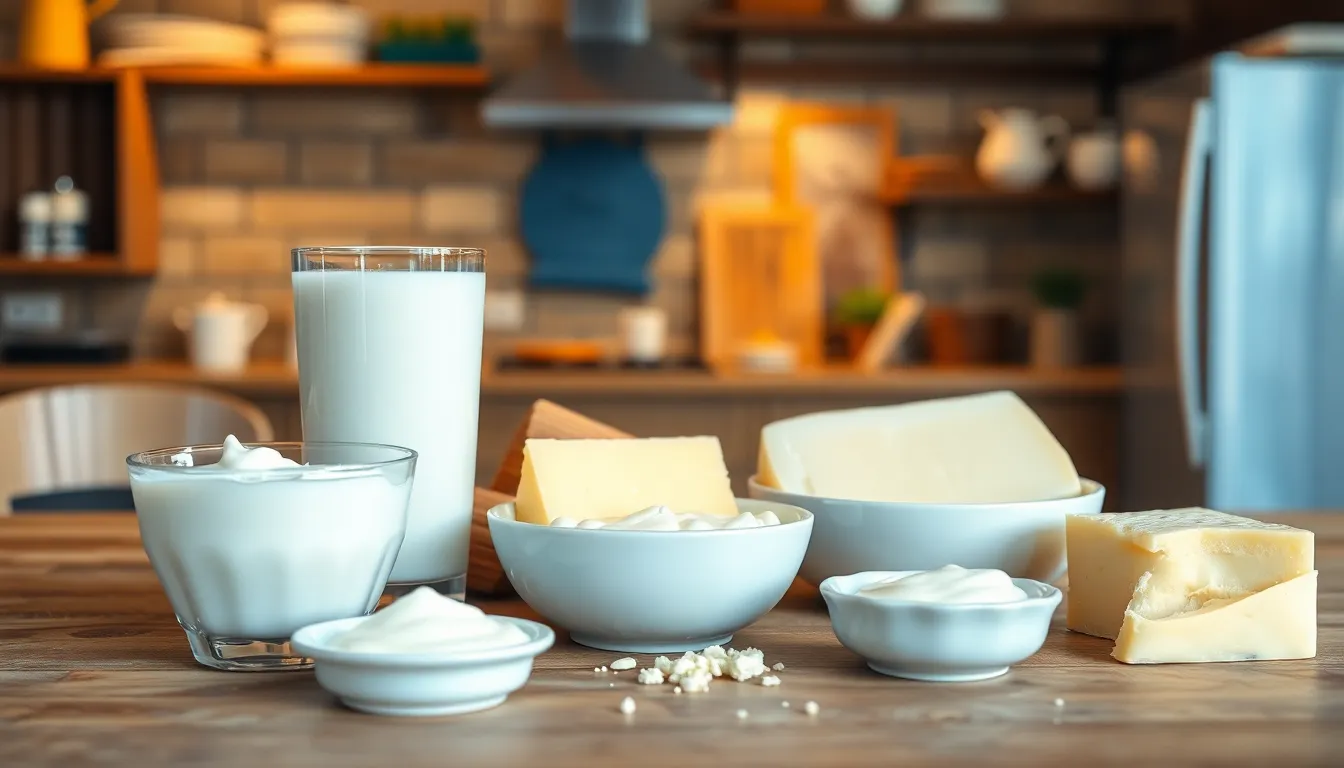Mayonnaise often finds itself in the middle of culinary debates, but one question seems to spread like butter on toast: Is mayonnaise a dairy product? Picture this—you’re at a picnic, and someone pulls out a jar of mayo, claiming it’s a dairy delight. Suddenly, you’re left wondering if you should pair it with your cheese platter or keep it far away from the milk.
Table of Contents
ToggleUnderstanding Mayonnaise
Mayonnaise often sparks debate regarding its classification. It’s essential to explore its ingredients and common misconceptions for clarity.
Ingredients of Mayonnaise
Mayonnaise consists primarily of egg yolks, oil, and vinegar or lemon juice. Egg yolks act as an emulsifier, which helps blend oil and vinegar smoothly. Oil provides the creamy texture that mayonnaise is known for. Vinegar or lemon juice adds acidity and enhances flavor. This combination creates a stable mixture that does not involve any dairy products. In essence, the fundamental ingredients establish mayonnaise as a distinctly non-dairy item.
Common Misconceptions
Many people mistakenly associate mayonnaise with dairy products, often due to its creamy appearance. Some believe that because it has a rich texture, it must contain milk or cream. Additionally, the confusion may stem from pairing mayonnaise with dairy-based items like cheese or sour cream in recipes. Clarifying that mayonnaise is an emulsion of oil and egg yolks helps dispel these myths. Understanding this detail separates mayonnaise from the dairy category, reinforcing its identity as a standalone condiment.
Dairy Products Defined

Dairy products come from the milk of mammals. Milk constitutes the primary source, and various processing techniques lead to a wide range of products. Understanding what qualifies as dairy helps clarify misconceptions.
What Qualifies as Dairy?
Dairy products include items produced from animal milk, particularly from cows, goats, and sheep. Ingredients such as lactose, a sugar found in milk, must be present for a food item to be considered dairy. Additionally, any food that primarily comprises milk, or its derivatives, falls within this category. Cream, cheese, and yogurt exemplify this definition.
Examples of Dairy Products
Several common dairy products exist in everyday diets. Milk serves as the base for many, such as yogurt, cheese, and butter. Ice cream also qualifies as a dairy product due to its milk content. Cream cheese, ricotta, and sour cream further illustrate the variety within this category. Each product offers unique culinary applications while sharing the common element of dairy origins.
Is Mayonnaise a Dairy Product?
Mayonnaise is often misunderstood due to its creamy texture. This condiment contains no dairy ingredients, firmly categorizing it as a non-dairy item.
Analysis of Ingredients
Mayonnaise consists of egg yolks, oil, and either vinegar or lemon juice. This combination creates an emulsion where the oil and egg yolks blend smoothly together, forming a stable mixture. No milk or dairy-derived substances appear in its ingredients. The absence of dairy is crucial; it establishes mayonnaise as distinct from products like cheese or sour cream, often mistaken as similar due to texture. Understanding these components clarifies why mayonnaise does not belong in the dairy category.
Nutritional Profile
The nutritional profile of mayonnaise varies depending on the specific brand and formulation. Typically, one tablespoon contains about 100 calories, with a significant amount of fat, primarily from oil. Mayonnaise has no lactose, which suits lactose-intolerant individuals. It offers small amounts of vitamins, such as vitamin E, due to the oils used. Some variations may contain added flavors or preservatives, but none include dairy products. This profile reinforces its classification as non-dairy and highlights its common usage as a condiment in various recipes.
Popular Myths About Mayonnaise
Misunderstandings abound regarding mayonnaise and its classification. Commonly, it’s believed that mayonnaise falls under the dairy category due to its creamy texture. This confusion primarily stems from how mayonnaise often accompanies dairy products in recipes, like in potato salads and dips.
Myth vs. Fact
Dairy products originate from mammal milk. Mayonnaise contains no milk or its derivatives, making it a non-dairy item. A common myth claims mayonnaise is rich in lactose. In reality, no lactose exists in standard mayonnaise formulas, ensuring it’s suitable for those with lactose intolerance. This knowledge dissipates myths linking mayonnaise to dairy items.
Cultural Perceptions
Cultural views shape beliefs about food items, creating varied associations with mayonnaise. For instance, in American cuisine, it’s often seen as a go-to condiment. Some culinary traditions may emphasize mayonnaise’s creamy attributes, leading people to mistakenly categorize it as dairy. Connections to dishes like coleslaw and meat salads can further blur the lines. Recognition of mayonnaise’s ingredients helps clarify its non-dairy status, dispelling myths driven by cultural usage.
Understanding that mayonnaise is not a dairy product helps clear up the confusion surrounding its classification. With its primary ingredients being egg yolks, oil, and vinegar or lemon juice, mayonnaise stands apart from dairy items that derive from milk. This distinction is crucial for those with dietary restrictions or lactose intolerance.
By recognizing mayonnaise’s unique composition, individuals can confidently use it in various recipes without worrying about dairy-related concerns. The myths surrounding mayonnaise’s dairy status often stem from its creamy texture and culinary pairings, but it’s essential to embrace its true identity as a non-dairy condiment.





